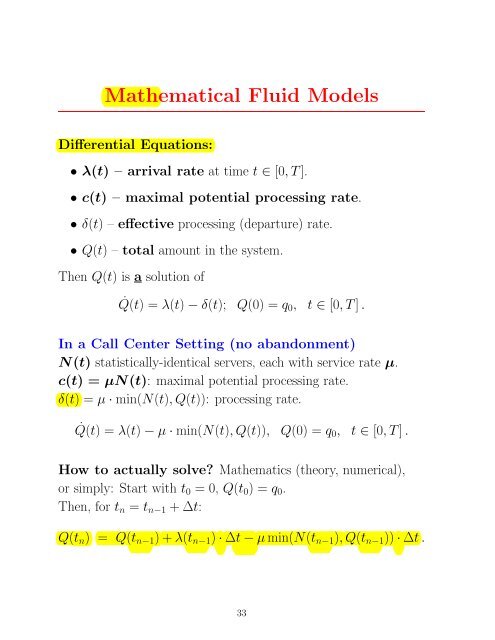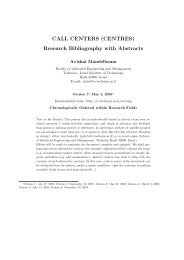PDF-6.4MB - Faculty of Industrial Engineering and Management
PDF-6.4MB - Faculty of Industrial Engineering and Management
PDF-6.4MB - Faculty of Industrial Engineering and Management
You also want an ePaper? Increase the reach of your titles
YUMPU automatically turns print PDFs into web optimized ePapers that Google loves.
Mathematical Fluid Models<br />
Differential Equations:<br />
• λ(t) – arrival rate at time t ∈ [0, T ].<br />
• c(t) – maximal potential processing rate.<br />
• δ(t) – effective processing (departure) rate.<br />
• Q(t) – total amount in the system.<br />
Then Q(t) is a solution <strong>of</strong><br />
˙Q(t) = λ(t) − δ(t); Q(0) = q0, t ∈ [0, T ] .<br />
In a Call Center Setting (no ab<strong>and</strong>onment)<br />
N(t) statistically-identical servers, each with service rate µ.<br />
c(t) = µN(t): maximal potential processing rate.<br />
δ(t) = µ · min(N(t), Q(t)): processing rate.<br />
˙Q(t) = λ(t) − µ · min(N(t), Q(t)), Q(0) = q0, t ∈ [0, T ] .<br />
How to actually solve? Mathematics (theory, numerical),<br />
or simply: Start with t0 = 0, Q(t0) = q0.<br />
Then, for tn = tn−1 + ∆t:<br />
Q(tn) = Q(tn−1) + λ(tn−1) · ∆t − µ min(N(tn−1), Q(tn−1)) · ∆t .<br />
33
















